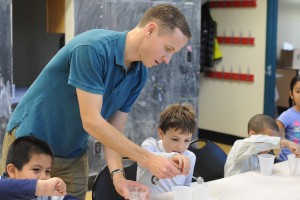The Carnegie Foundation recently selected the University for its 2015 Community Engagement Classification. The award is for institutions that have demonstrated community engagement and founded on evidence-based documentation.
The University was also selected for this recognition in 2008.
According to the New England Resource Center for Higher Education, the Carnegie Community Engagement Classification considers community engagement a collaboration between institutions of higher education and their larger communities for the mutually beneficial exchange of knowledge and resources in a context of partnership and reciprocity.
“We did our initial application in 2008, and it’s an extensive process where they ask numbers such as how many learning classes we have, how many professors are engaged, how many students take these classes, specific examples of partnerships and how they have developed, outcomes, and how the community is involved in all of this,” said Director of Center for Community Partnerships Cathy Lechowicz. “This time around, they ask you what has changed since last time, and how you have further engaged with the community.”
The projects and activities considered in this Classification involve not just the participation of students, administrators, and professors, but also the community members. According to Lechowicz, the community is Middletown-centric, but can also range from Connecticut to even larger areas.
“The whole idea is that the engagement isn’t just about the University, but that it’s about working in the world and how to engage the world in the work that you’re doing,” Lechowicz said. “It’s a partnership where you work with agencies and individuals to try to address some public need or some public project.”
The University has accomplished major achievements since its classification in 2010. These include institutional advances such as the establishment of the Patricelli Center for Social Entrepreneurship, and the Allbritton Center for the Study of Public Life, which both did not exist five years ago. Specific projects include the establishment of the Center for Prison Education and the growth of WesReads and WesMath—both of which started out with half a dozen students and currently have more than 70 students who go to the Macdonough School in Middletown on a regular basis.
Director of Patricelli Center for Social Entrepreneurship Makaela Kingsley shared her views on the importance of community engagement.
“At the Patricelli Center for Social Entrepreneurship, we believe that community engagement and collaboration are paramount to all social impact work,” Kingsley said. “In fact, innovation or ‘charity’ alone—without cultural competence and involvement by relevant communities—can be destructive. Wesleyan students are better entrepreneurs and intrapreneurs because our students and faculty are highly engaged citizens.”
Lechowicz added that the challenge of the institution is helping students to develop these projects and provide them that autonomy that many of the students want, while also providing institutional support for them in a way they can further their project.
Another example of the University’s community engagement is the Green Street Teaching and Learning Center, a community-based studio that engages different members of the Middletown community such as students and faculty, local artists, and faculty from Middletown Community College. Most of the classes offered a combination of math and science with art and are taught to students of grades 1-8.
Director of the Service-Learning Center Barbara Juhasz commented on the role of this organization.
“Green Street is a wonderful example of community partnership that functions in so many different ways that involves students on a regular basis, involves faculty in service-learning courses, and provides a great mechanism for students to be more involved in the community,” Juhasz said.
Anna Flurry ’17, student coordinator for Green Street Teaching and Learning Center, commented on what the organization has to offer in terms of community engagement.
“Green Street offers this great opportunity for Wesleyan students to get out of the college bubble and interact with the Middletown community in a positive way,” Flurry said. “I think it’s really important to be aware that we’re part of a much bigger community called Middletown. We’ve been able to create many connections with the town around us, which has enabled us to get rid of the idea of otherness. I personally feel like I have a much stronger connection to Middletown.”
Through this partnership, the Carnegie Foundation provides classified institutions with feedback on general themes throughout the application process such as insight in areas they can focus on and develop. Lechowicz praised the helpfulness of this process.
“We talk with other schools and work with other people, but you certainly have your blinders on in a sense, Lechowics said. “It’s nice to get feedback from outside folks and the framework for engagement they provide.”
The next opportunity to apply for Classification will be 10 years from now. This is an extension of the prior five years due to existing partnership, which shows the plan for the long-term relationship the Foundation and the University will have.
For information on how to get involved, engagement work on campus, and community events, students can sign up for the ENGAGED newsletter or the Civic Engagement Fellow newsletter.

Comments are closed